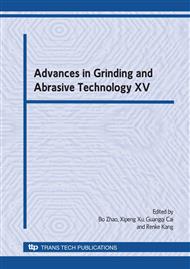p.182
p.187
p.192
p.198
p.205
p.210
p.216
p.223
p.228
Simulation on the Indentation of Large Grain in the Semi-Fixed Abrasive Plate with Discrete Element Method
Abstract:
This paper analyses the influence of indenter’s vertex angle on the ‘trap’ effect of the semi-fixed abrasive plate (SAP) with discrete element method. The indenters of different degree vertex angle are generated by discrete element method, then the indenter is applied processing velocity, which let the indenter press into the SAP, finally three curves of normal force and displacement are gained. From the curves, the normal force of the indenters doesn’t increase quickly and stay in stable in the beginning, because the SAP is full of pore, which let the indenter easily press into the SAP. Through the above indenter simulation, the relations between the lasting time of the ‘trap’ effect and the indenter’s vertex angle are in reverse proportion, if the indenter’s vertex angle is smaller, the lasting time of the ‘trap’ effect of SAP is longer, and the size of large grain is an influence factor in the ‘trap’ effect of SAP.
Info:
Periodical:
Pages:
205-209
Citation:
Online since:
September 2009
Authors:
Price:
Сopyright:
© 2009 Trans Tech Publications Ltd. All Rights Reserved
Share:
Citation:


